Abstract
It has recently been shown that factors in addition to interleukin-2 (IL-2) are required for the proliferation or differentiation of at least some murine T-cell lines. We have previously shown that conditioned medium from human mononuclear cells stimulated with phorbol ester and staphylococcal enterotoxin A is superior to commercial sources of IL-2 for the long-term growth of human T cells. We have identified in these supernatants a non-IL-2 factor (synergistic factor, SF) which synergizes with JURKAT IL-2 in the long-term growth of human T cells. [3H]TdR incorporation by IL-2-dependent human T cells after growth in IL-2 or SF alone for 14 days was slight, but significant. By contrast, growth in a combination of SF and IL-2 for 14 days stimulated [3H]TdR incorporation 10-20-fold higher, generally equal to the high incorporation measured when cells were grown in the presence of the conditioned medium from which SF was obtained. In a standard 2-day IL-2 assay, there was no correlation between activity and long-term growth-promoting ability. These results suggest that the 14-day assay better discerns the growth-promoting activity of various factors or combinations of factors. The mechanism of this interaction between SF and IL-2 remains to be elucidated. It is clear, however, that T-cell growth factor activity, when assessed by the long-term growth of human T cells, is not due to interleukin-2 alone.
Full text
PDF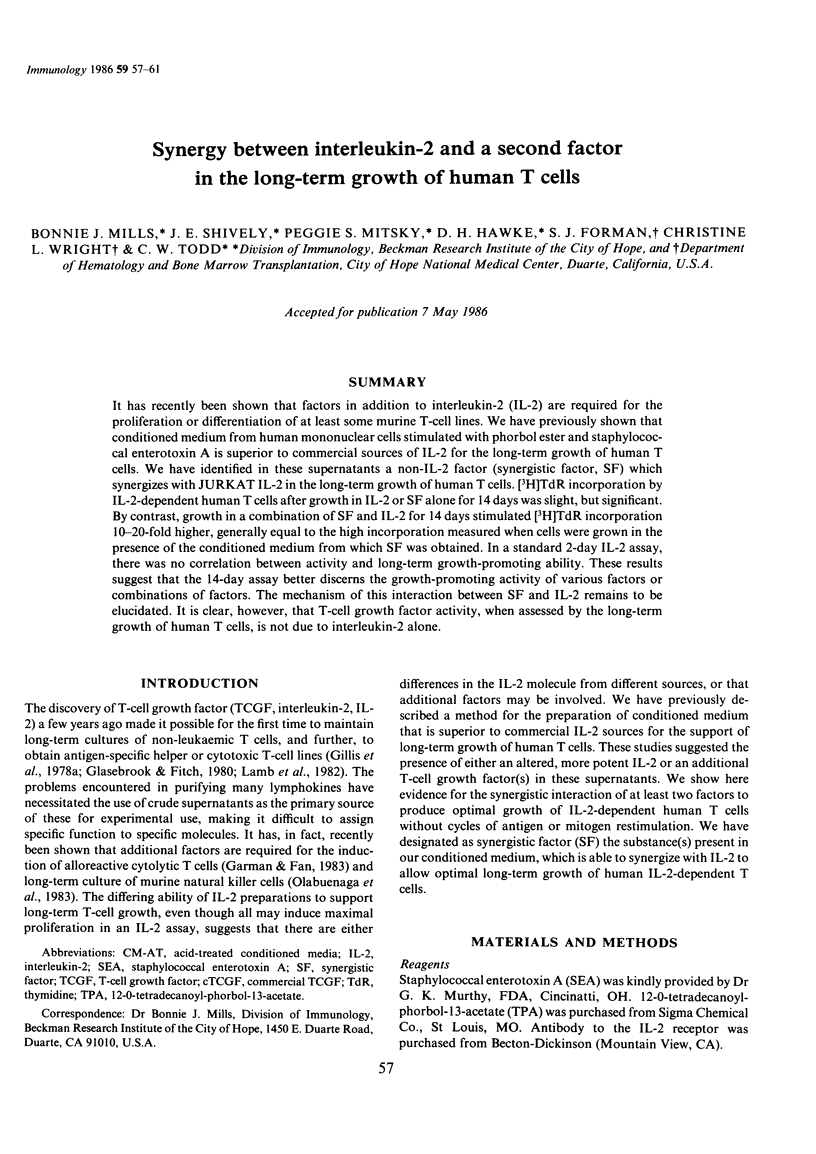
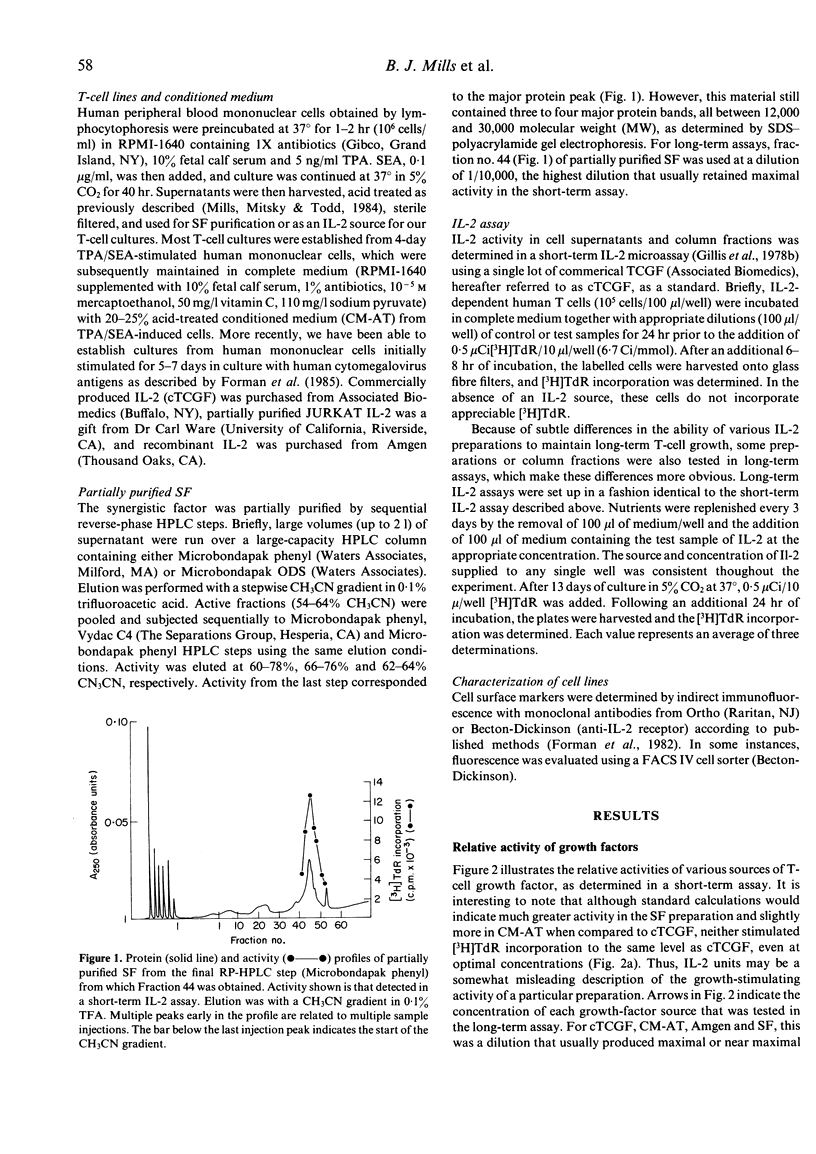
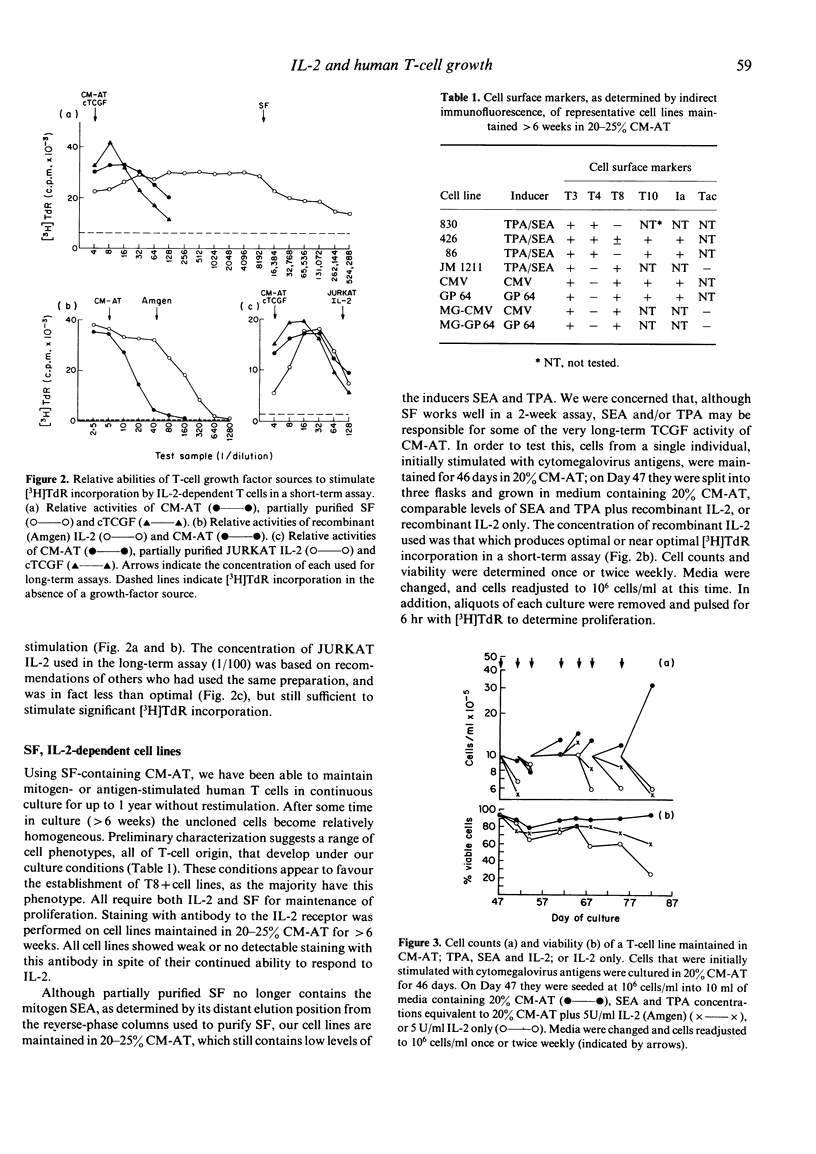
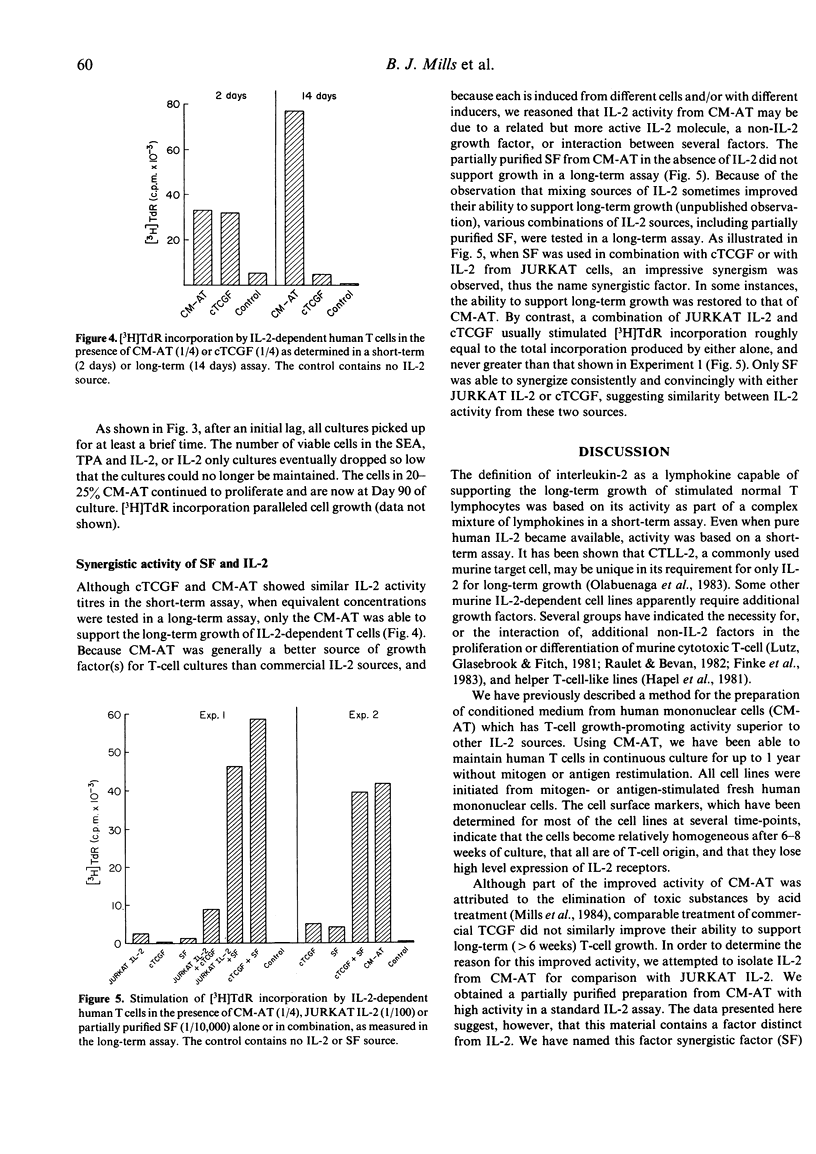
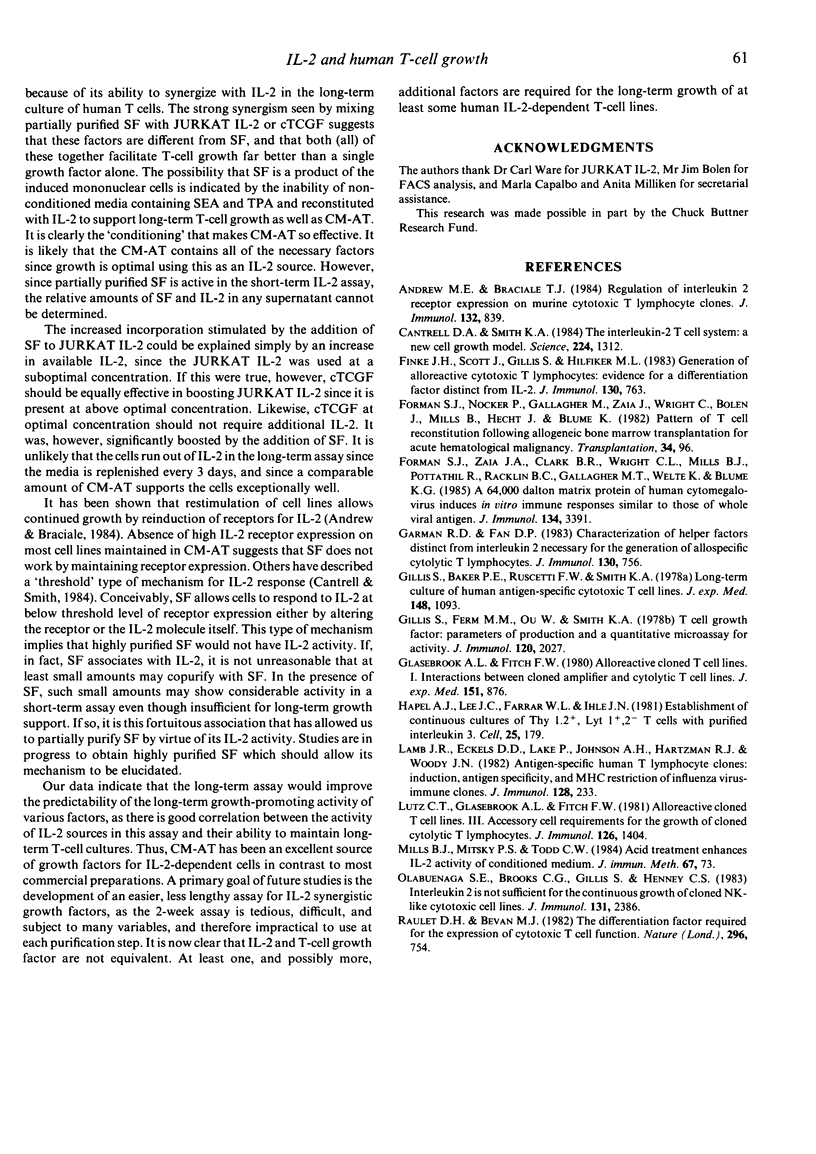
Selected References
These references are in PubMed. This may not be the complete list of references from this article.
- Andrew M. E., Braciale V. L., Braciale T. J. Regulation of interleukin 2 receptor expression on murine cytotoxic T lymphocyte clones. J Immunol. 1984 Feb;132(2):839–844. [PubMed] [Google Scholar]
- Cantrell D. A., Smith K. A. The interleukin-2 T-cell system: a new cell growth model. Science. 1984 Jun 22;224(4655):1312–1316. doi: 10.1126/science.6427923. [DOI] [PubMed] [Google Scholar]
- Finke J. H., Scott J., Gillis S., Hilfiker M. L. Generation of alloreactive cytotoxic T lymphocytes: evidence for a differentiation factor distinct from IL 2. J Immunol. 1983 Feb;130(2):763–767. [PubMed] [Google Scholar]
- Garman R. D., Fan D. P. Characterization of helper factors distinct from interleukin 2 necessary for the generation of allospecific cytolytic T lymphocytes. J Immunol. 1983 Feb;130(2):756–762. [PubMed] [Google Scholar]
- Gillis S., Baker P. E., Ruscetti F. W., Smith K. A. Long-term culture of human antigen-specific cytotoxic T-cell lines. J Exp Med. 1978 Oct 1;148(4):1093–1098. doi: 10.1084/jem.148.4.1093. [DOI] [PMC free article] [PubMed] [Google Scholar]
- Gillis S., Ferm M. M., Ou W., Smith K. A. T cell growth factor: parameters of production and a quantitative microassay for activity. J Immunol. 1978 Jun;120(6):2027–2032. [PubMed] [Google Scholar]
- Glasebrook A. L., Fitch F. W. Alloreactive cloned T cell lines. I. Interactions between cloned amplifier and cytolytic T cell lines. J Exp Med. 1980 Apr 1;151(4):876–895. doi: 10.1084/jem.151.4.876. [DOI] [PMC free article] [PubMed] [Google Scholar]
- Hapel A. J., Lee J. C., Farrar W. L., Ihle J. N. Establishment of continuous cultures of thy1.2+, Lyt1+, 2-T cells with purified interleukin 3. Cell. 1981 Jul;25(1):179–186. doi: 10.1016/0092-8674(81)90242-7. [DOI] [PubMed] [Google Scholar]
- Lamb J. R., Eckels D. D., Lake P., Johnson A. H., Hartzman R. J., Woody J. N. Antigen-specific human T lymphocyte clones: induction, antigen specificity, and MHC restriction of influenza virus-immune clones. J Immunol. 1982 Jan;128(1):233–238. [PubMed] [Google Scholar]
- Lutz C. T., Glasebrook A. L., Fitch F. W. Alloreactive cloned T cell lines. III. Accessory cell requirements for the growth of cloned cytolytic T lymphocytes. J Immunol. 1981 Apr;126(4):1404–1408. [PubMed] [Google Scholar]
- Mills B. J., Mitsky P. S., Todd C. W. Acid treatment enhances IL-2 activity of conditioned medium. J Immunol Methods. 1984 Feb 24;67(1):73–78. doi: 10.1016/0022-1759(84)90086-3. [DOI] [PubMed] [Google Scholar]
- Olabuenaga S. E., Brooks C. G., Gillis S., Henney C. S. Interleukin 2 is not sufficient for the continuous growth of cloned NK-like cytotoxic cell lines. J Immunol. 1983 Nov;131(5):2386–2391. [PubMed] [Google Scholar]
- Raulet D. H., Bevan M. J. A differentiation factor required for the expression of cytotoxic T-cell function. Nature. 1982 Apr 22;296(5859):754–757. doi: 10.1038/296754a0. [DOI] [PubMed] [Google Scholar]


